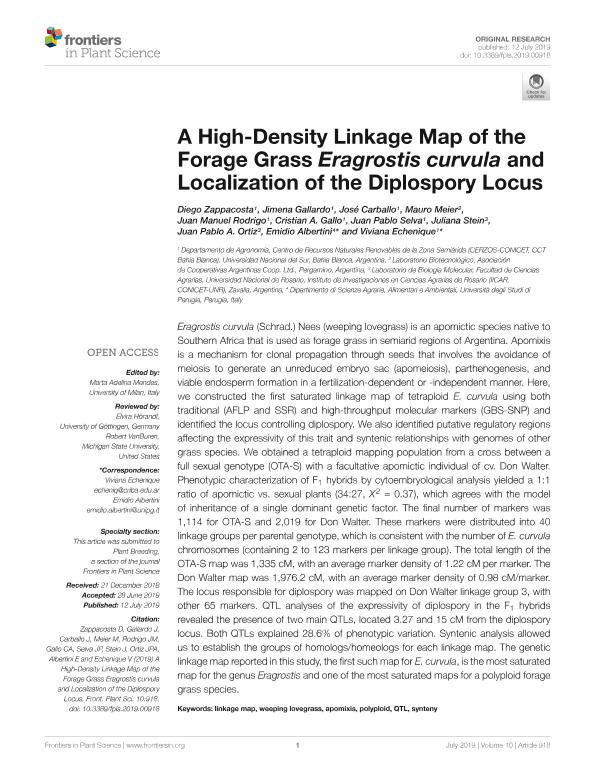Artículo
A High-Density Linkage Map of the Forage Grass Eragrostis curvula and Localization of the Diplospory Locus
Zappacosta, Diego Carlos ; Gallardo, Jimena Alicia
; Gallardo, Jimena Alicia ; Carballo, José
; Carballo, José ; Meier, Mauro Sebastián
; Meier, Mauro Sebastián ; Rodrigo, Juan Manuel
; Rodrigo, Juan Manuel ; Gallo, Cristian Andrés
; Gallo, Cristian Andrés ; Selva, Juan Pablo
; Selva, Juan Pablo ; Stein, Juliana
; Stein, Juliana ; Ortiz, Juan Pablo Amelio
; Ortiz, Juan Pablo Amelio ; Albertini, Emidio; Echenique, Carmen Viviana
; Albertini, Emidio; Echenique, Carmen Viviana
 ; Gallardo, Jimena Alicia
; Gallardo, Jimena Alicia ; Carballo, José
; Carballo, José ; Meier, Mauro Sebastián
; Meier, Mauro Sebastián ; Rodrigo, Juan Manuel
; Rodrigo, Juan Manuel ; Gallo, Cristian Andrés
; Gallo, Cristian Andrés ; Selva, Juan Pablo
; Selva, Juan Pablo ; Stein, Juliana
; Stein, Juliana ; Ortiz, Juan Pablo Amelio
; Ortiz, Juan Pablo Amelio ; Albertini, Emidio; Echenique, Carmen Viviana
; Albertini, Emidio; Echenique, Carmen Viviana
Fecha de publicación:
12/07/2019
Editorial:
Frontiers
Revista:
Frontiers in Plant Science
ISSN:
1664-462X
Idioma:
Inglés
Tipo de recurso:
Artículo publicado
Clasificación temática:
Resumen
Eragrostis curvula (Schrad.) Nees (weeping lovegrass) is an apomictic species native to Southern Africa that is used as forage grass in semiarid regions of Argentina. Apomixis is a mechanism for clonal propagation through seeds that involves the avoidance of meiosis to generate an unreduced embryo sac (apomeiosis), parthenogenesis, and viable endosperm formation in a fertilization-dependent or -independent manner. Here, we constructed the first saturated linkage map of tetraploid E. curvula using both traditional (AFLP and SSR) and high-throughput molecular markers (GBS-SNP) and identified the locus controlling diplospory. We also identified putative regulatory regions affecting the expressivity of this trait and syntenic relationships with genomes of other grass species. We obtained a tetraploid mapping population from a cross between a full sexual genotype (OTA-S) with a facultative apomictic individual of cv. Don Walter. Phenotypic characterization of F1 hybrids by cytoembryological analysis yielded a 1:1 ratio of apomictic vs. sexual plants (34:27, X2 = 0.37), which agrees with the model of inheritance of a single dominant genetic factor. The final number of markers was 1,114 for OTA-S and 2,019 for Don Walter. These markers were distributed into 40 linkage groups per parental genotype, which is consistent with the number of E. curvula chromosomes (containing 2 to 123 markers per linkage group). The total length of the OTA-S map was 1,335 cM, with an average marker density of 1.22 cM per marker. The Don Walter map was 1,976.2 cM, with an average marker density of 0.98 cM/marker. The locus responsible for diplospory was mapped on Don Walter linkage group 3, with other 65 markers. QTL analyses of the expressivity of diplospory in the F1 hybrids revealed the presence of two main QTLs, located 3.27 and 15 cM from the diplospory locus. Both QTLs explained 28.6% of phenotypic variation. Syntenic analysis allowed us to establish the groups of homologs/homeologs for each linkage map. The genetic linkage map reported in this study, the first such map for E. curvula, is the most saturated map for the genus Eragrostis and one of the most saturated maps for a polyploid forage grass species.
Palabras clave:
APOMIXIS
,
LINKAGE MAP
,
POLYPLOID
,
QTL
,
SYNTENY
,
WEEPING LOVEGRASS
Archivos asociados
Licencia
Identificadores
Colecciones
Articulos(CERZOS)
Articulos de CENTRO REC.NAT.RENOVABLES DE ZONA SEMIARIDA(I)
Articulos de CENTRO REC.NAT.RENOVABLES DE ZONA SEMIARIDA(I)
Articulos(IICAR)
Articulos de INST. DE INVESTIGACIONES EN CIENCIAS AGRARIAS DE ROSARIO
Articulos de INST. DE INVESTIGACIONES EN CIENCIAS AGRARIAS DE ROSARIO
Citación
Zappacosta, Diego Carlos; Gallardo, Jimena Alicia; Carballo, José; Meier, Mauro Sebastián; Rodrigo, Juan Manuel; et al.; A High-Density Linkage Map of the Forage Grass Eragrostis curvula and Localization of the Diplospory Locus; Frontiers; Frontiers in Plant Science; 10; 12-7-2019; 1-17
Compartir
Altmétricas



